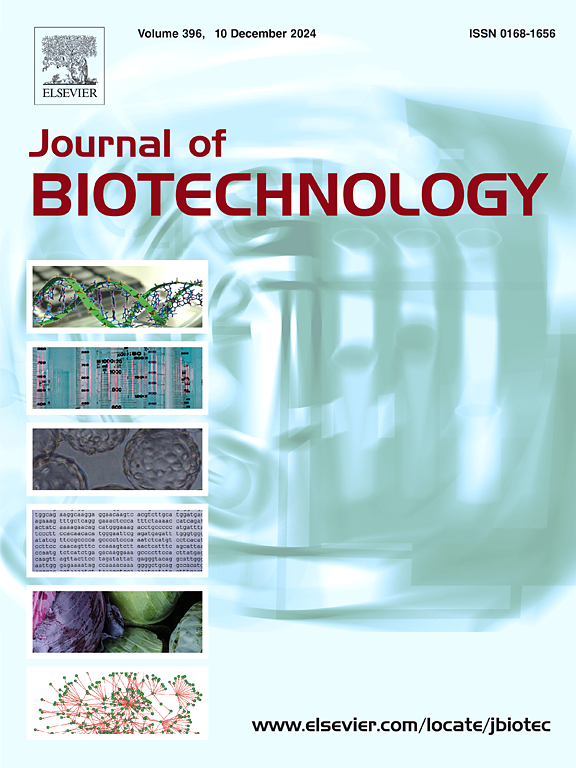基于DNA核酸内切酶i - scii的铜鱼无疤痕基因组编辑系统的建立。
IF 3.9
2区 生物学
Q2 BIOTECHNOLOGY & APPLIED MICROBIOLOGY
引用次数: 0
摘要
necator Cupriavidus necator是一种很有前途的微生物基质,能够固定CO 2并产生高的聚羟基烷酸酯产量。因此,人们探索了各种基因工程方法。虽然基于sacb的同源重组(HR)和CRISPR-Cas9在C. necator中显示出各自的优点和缺点,但其他工具,包括DNA内切酶i - scii介导的HR系统,可以实现精确、无疤痕的基因组编辑,而不需要大型数据库。我们开发了一个基于双质粒的I-SceI HR系统,通过改变起源复制和诱导系统,有效地在C. necator中进行基因删除和插入。构建pOH-4质粒,表达I-SceI,诱导第二次HR整合。传统的I-SceI表达策略无法在C. necator中触发第二HR,与之不同的是,仅用pOH-4进行转化就足以进行重组。优化了质粒固化策略,将培养温度提高到37℃,以消除高稳定性的pOH-4。利用优化后的系统,成功敲除了phaC1基因;将phaCBP-M-CPF4插入同一位点,得到一株新的聚3-羟基丁酸-co-5-羟基戊酸酯产菌。这种新建立的I-SceI HR技术大大简化了C. necator的基因组工程,将时间框架缩短到几周,并促进了其在合成生物学中的进一步应用。本文章由计算机程序翻译,如有差异,请以英文原文为准。
Development of a DNA endonuclease I-SceI-based scarless genome editing system for Cupriavidus necator
Cupriavidus necator is a promising microbial chassis capable of fixing CO₂ and producing high polyhydroxyalkanoate yields. Consequently, various genetic engineering methods have been explored. While sacB-based homologous recombination (HR) and CRISPR-Cas9 have shown both advantages and disadvantages in C. necator, alternative tools, including the DNA endonuclease I-SceI-mediated HR system could enable precise, scarless genome editing without requiring a large database. We developed a two-plasmid-based I-SceI HR system for efficient gene deletion and insertion in C. necator by altering origin replication and induction systems. The pOUO-1 plasmid was designed for conjugation-based genome integration via first HR, whereas the pOH-4 plasmid was constructed to express I-SceI, inducing second HR. Unlike conventional I-SceI expression strategies, which fail to trigger second HR in C. necator, transformation with pOH-4 alone was sufficient for recombination. A plasmid-curing strategy was optimized to eliminate the highly stable pOH-4 by increasing the incubation temperature to 37°C. Using this optimized system, the phaC1 gene was successfully knocked out; the phaCBP-M-CPF4 was inserted at the same site, resulting in a novel poly(3-hydroxybutyrate-co-5-hydroxyvalerate)-producing strain. This newly established I-SceI HR technique significantly simplifies genome engineering in C. necator, reducing the timeframe to a few weeks and facilitating its further applications in synthetic biology.
求助全文
通过发布文献求助,成功后即可免费获取论文全文。
去求助
来源期刊

Journal of biotechnology
工程技术-生物工程与应用微生物
CiteScore
8.90
自引率
2.40%
发文量
190
审稿时长
45 days
期刊介绍:
The Journal of Biotechnology has an open access mirror journal, the Journal of Biotechnology: X, sharing the same aims and scope, editorial team, submission system and rigorous peer review.
The Journal provides a medium for the rapid publication of both full-length articles and short communications on novel and innovative aspects of biotechnology. The Journal will accept papers ranging from genetic or molecular biological positions to those covering biochemical, chemical or bioprocess engineering aspects as well as computer application of new software concepts, provided that in each case the material is directly relevant to biotechnological systems. Papers presenting information of a multidisciplinary nature that would not be suitable for publication in a journal devoted to a single discipline, are particularly welcome.
 求助内容:
求助内容: 应助结果提醒方式:
应助结果提醒方式:


